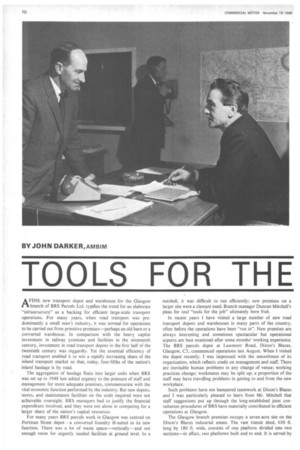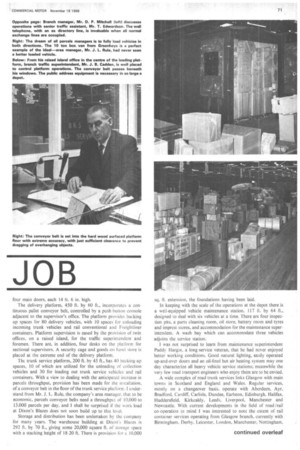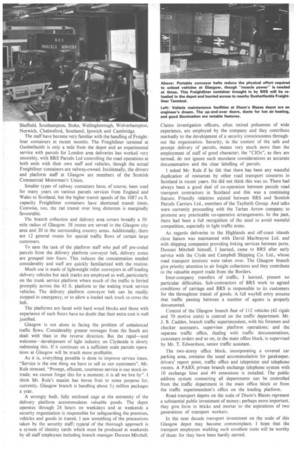TOOLS FOR THE JOB
Page 72

Page 73

Page 74

If you've noticed an error in this article please click here to report it so we can fix it.
BYJOHN DARKER,AMBIM
A FINE new transport depot and warehouse for the Glasgow
branch of BRS Parcels Ltd. typifies the trend for an elaborate "infrastructure" as a backing for efficient large-scale transport operations. For many years, when road transport was predominantly a small man's industry, it was normal for operations to be carried out from primitive premises—perhaps an old barn or a converted warehouse. In comparison with the heavy capital investment in railway premises and facilities in the nineteenth century, investment in road transport depots in the first half of the twentieth century was niggardly. Yet the essential efficiency of road transport enabled it to win a rapidly increasing share of the inland transport market so that, today, four-fifths of the nation's inland haulage is by road.
The aggregation of haulage fleets into larger units when BRS was set up in 1948 lent added urgency to the pressure of staff and management for more adequate premises, commensurate with the vital economic function performed by the industry. But new depots, 'stores, and maintenance facilities on the scale required were not achievable overnight. BRS managers had to justify the financial expenditure involved, and they were not alone in competing for a larger share of the nation's capital resources.
For many years BRS parcels work in Glasgow was centred on Portman Street depot a converted foundry ill-suited to its new function. There was a lot of waste space—vertically—and not enough room for urgently needed facilities at ground level. In a nutshell, it was difficult to run efficiently; new premises on a larger site were a clamant need. Branch manager Duncan Mitchell's pleas for real "tools for the job" ultimately bore fruit.
In recent years I have visited a large number of new road transport depots and warehouses in many parts of the country, often before the operations have been "run in". New premises are always interesting and sometimes spectacular but operational aspects are best examined after some months' working experience. The BRS parcels depot at Lawmoor Road, Dixon's Blazes, Glasgow, C5, commenced operations last August. When I visited the depot recently, I was impressed with the smoothness of its organization, which reflects credit on management and staff. There are inevitable human problems in any change of venue; working practices change; workmates may be split up; a proportion of the staff may have travelling problems in getting to and from the new workplace.
Such problems have not hampered teamwork at Dixon's Blazes and I was particularly pleased to learn from Mr. Mitchell that staff suggestions put up through the long-established joint consultation procedures of BRS have materially contributed to efficient operations at Glasgow.
The Glasgow branch premises occupy a seven-acre site on the Dixon's Blazes industrial estate. The vast transit shed, 650 ft. long by 180 ft. wide, consists of one platform divided into two sections—in effect, two platforms built end to end. It is served by four main doors, each 14 ft. 6 in. high.
The delivery platform, 450 ft. by 60 ft., incorporates a continuous pallet conveyor belt, controlled by a push button console adjacent to the supervisor's office. The platform provides backing up spaces for 80 delivery vehicles, with 10 spaces for unloading incoming trunk vehicles and rail conventional and Freightliner containers. Platform supervision is eased by the provision of twin offices. on a raised island, for the traffic superintendent and foremen. There are, in addition, four desks on the platform for sectional supervisors. A security cage and goods on hand store is placed at the extreme end of the delivery platform.
Th€ trunk service platform, 200 ft. by 43 ft., has 40 backing-up spaces, 10 of which are utilized for the unloading of collection vehicles and 30 for loading out trunk service vehicles and rail containers. With a view to dealing with the anticipated increase in parcels throughput, provision has been made for the installation, of a conveyor belt in the floor of the trunk service platform. I understand from Mr. J. L. Rule, the company's area manager. that to be economic, parcels conveyor belts need a throughput of 10.000 to 13.000 parcels per day, and 1 shall be surprised if the work-load at Dixon's Blazes does not soon build up to this level.
Storage and distribution has been undertaken by the company for many years. The warehouse building at Dixon's Blazes is 292 ft. by 70 ft., giving some 20,000 square ft. of storage space with a stacking height of 18-20 ft. There is provision for a 10.000
sq. ft. extension, the foundations having been laid.
In keeping with the scale of the operations at the depot there is a well-equipped vehicle maintenance station, 117 ft. by 64 ft., designed to deal with six vehicles at a time. There are four inspection pits, a parts cleaning room, oil store, battery room and tyres and imprest stores, and accommodation for the maintenance superintendent. A wash bay which can accommodate three vehicles adjoins the service station.
I was not surprised to learn from maintenance superintendent Paddy Hargin, a long-service veteran, that he had never enjoyed better working conditions. Good natural lighting, easily operated up-and-over doors and an oil-fired hot air heating system may one day characterize all heavy vehicle service stations; meanwhile the very few road transport engineers who enjoy them are to be envied.
A wide complex of road trunk services links Glasgow with main towns in Scotland and England and Wales. Regular services, mostly on a changeover basis, operate with Aberdeen, Ayr, Bradford, Cardiff, Carlisle, Dundee, Earlston, Edinburgh, Halifax, Huddersfield, Kirkcaldy, Leeds, Liverpool, Manchester and Newcastle. With current developments in the field of road/rail co-operation in mind I was interested to note the extent of rail container services operating from Glasgow branch, currently with Birmingham, Derby, Leicester, London, Manchester, Nottingham, Sheffield, Southampton, Stoke, Wellingborough, Wolverhampton, Norwich, Chelmsford, Southend, Ipswich and Cambridge.
The staff have become very familiar with the handling of Freightliner containers in recent months. The Freightliner terminal at Gushetfaulds is only a mile from the depot and an experimental service with parcels for London area deliveries has worked very smoothly, with BRS Parcels Ltd controlling the road operations at both ends with their own staff and vehicles, though the actual Freightliner containers are railway-owned. Incidentally, the drivers and platform staff at Glasgow are members of the Scottish Commercial Motormen's Union.
Smaller types of railway containers have, of course, been used for many years on various parcels services from England and Wales to Scotland, but the higher transit speeds of the 1087 cu ft. capacity Freightliner containers have shortened transit times. Costwise, too, the rail transit over long distances is marginally favourable.
The branch collection and delivery area covers broadly a 30mile radius of Glasgow. 38 routes are served in the Glasgow city area and 30 in the surrounding country areas. Additionally, there are 12 general routes for special traffic flows of certain large customers.
To ease the task of the platform staff who pull off pre-coded parcels from the delivery platform conveyor belt, delivery zones are 'grouped into fours. This reduces the concentration needed considerably and staff are quickly familiarized with the routine.
Much use is made of lightweight roller conveyors in offloading delivery vehicles but sack tracks are employed as well, particularly on the trunk service platform where much of the traffic is ferried promptly across the 45 ft. platform to the waiting trunk service vehicles. The delivery platform conveyor belt can be readily stopped in emergency. or to allow a loaded sack truck to cross the belt.
The platforms are faced with hard wood blocks and those with experience of such floors have no doubt that their extra cost is well justified.
Glasgow is not alone in facing the problem of unbalanced traffic flows. Considerably greater tonnages from the South are dealt with than in the reverse direction. But the rapid—and welcome—development of light industry on Clydeside is slowly redressing this. If it continues on a sufficient scale parcels operations at Glasgow will be much more profitable.
As it is, everything possible is done to improve service times. "Service is the one thing we have to sell to our customers", Mr. Rule stressed. "Prompt, efficient, courteous service is our stock-intrade; we cannot forget this for a moment; it is all we live by". I think Mr. Rule's maxim has borne fruit to some purpose for, currently, Glasgow branch is handling about 54million packages a year.
A strongly built, fully enclosed cage at the extremity of the delivery platform accommodates valuable goods.. The depot operates through 24 hours on weekdays and at weekends a security organization is responsible for safeguarding the premises, vehicles and goods in transit. I saw something of the precautions taken by the security staff; typical of the thorough approach is a system of identity cards which must be produced at weekends by all staff employees including branch manager Duncan Mitchell. Claims investigation officers, often retired policemen of wide experience, are employed by the company and they contribute markedly to the development of a security consciousness throughout the organization. Security, in the context of the safe and prompt delivery of parcels, means very much more than the employment of staff of good character; the "CIOs", as they are termed, do not ignore such mundane considerations as accurate documentation and the clear labelling of parcels.
I asked Mr. Rule if he felt that there has been any wasteful duplication of resources by other road transport concerns in Scotland in recent years. He did not think this was so. There had always been a good deal of co-operation between parcels road transport contractors in Scotland and this was a continuing feature. Friendly relations existed between BRS and Scottish Parcels Carriers Ltd., members of the Tayforth Group. And talks were currently proceeding with the Tartan Arrow company to promote any practicable co-operative arrangements. In the past, there had been a full recognition of the need to avoid wasteful competition, especially in light traffic areas.
As regards deliveries to the Highlands and off-coast islands close liaison was maintained with David Macbrayne Ltd. and with shipping companies providing linking services between ports. Duncan Mitchell himself, I learned, came to BRS after early service with the Clyde and Campbell Shipping Co. Ltd., whose road transport interests were taken over. The Glasgow branch give priority attention to air freight collections and they contribute to the valuable export trade from the Borders.
Inter-company transfers of traffic, I learned, present no . particular difficulties. Sub-contractors of BRS work to agreed conditions of carriage and BRS is responsible to its customers for the throughout transit of goods. A full waybill entry ensures that traffic passing between a number of agents is properly documented.
Control of the Glasgow branch fleet of 112 vehicles (42 rigids and 70 motive units) is centred on the traffic department. Mr. J. B. Cadden, branch traffic superintendent, with his foremen and checker assistants, supervises platform operations; and the separate traffic office, dealing with traffic documentations, customers orders and so on, in, the main office block, is supervised by Mr. T. Edwardson, senior traffic assistant.
The two-storey office block, incorporating a covered car parking area, contains the usual accommodation for gatekeeper, drivers' report point, traffic office and teleprinter and telephone' rooms. A PABX private branch exchange telephone system with 10 exchange lines and 49 extensions is installed. The public address system connecting all departments can be controlled from the traffic department in the main office block or from the traffic superintendent's office on the loading platform.
Road transport depots on the scale of Dixon's Blazes represent a substantial public investment of money; perhaps more important, they give form in bricks and mortar to the aspirations of two generations of transport workers.
In the next decade transport investment on the scale of this Glasgow depot may become commonplace. I hope that the transport employees wielding such excellent tools will be worthy of them: for they have been hardly earned.




































































































































